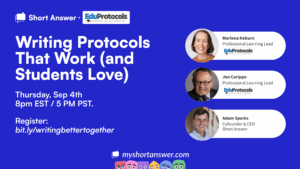Long gone are the days – we hope! – of teachers standing at the front of the classroom and talking for 45 minutes while students sit at their desks silently taking notes. Students crave the opportunity to actively do things: interact with their friends, build relationships, and show off their creative abilities to their classmates.
In other words, our students are looking for agency in the classroom: the ability to get out of the passenger seat and take the wheel on their own, individualized learning journey.
In this blog, we highlight 3 strategies, each with helpful resources, that you can use in your classroom to inspire agency and build self-motivated, independent, and curious lifelong learners. Be sure to check out our accompanying Short PD video on student agency that delves into many of the topics discussed here.
1. Agency Starts with Setting Authentic Goals
What do our students really want to get out of their time in the classroom? Are there certain skills, interests, or questions that they want to dig into? Prompting students to think about and express those goals enables us to tailor lesson plans to help them meet their goals.
One question to ask your students about goal-setting: “what does a successful learning experience look like to you?” By co-creating these criteria for success (or learning objectives) alongside students, it shows them that they have a voice in their learning journey. They get a say in both what they learn and how they learn it.

We can also help students recognize that there isn’t just one way to meet those goals: does “success” look like a service project, video, interview series, or poster presentation, and not just a traditional 5 paragraph essay? Creating assignments with Universal Design for Learning principles in mind allows for students to be flexible in how they show what they know, and the choice that this flexibility provides goes a long way towards developing agency.
Resource: WestEd’s Supporting Student Agency Through Formative Assessment
2. Agency is Reinforced by Positive Relationships
Once students begin feeling empowered in the driver’s seat, it’s natural for them to want to share those positive feelings with others. While agency can certainly be an exercise in independence, it’s important to recognize the collaborative and interpersonal aspects of it as well.
What does it look like for students to bring others in to their own learning process? Facilitating opportunities for students to share and discuss their work with others is a great way to build supportive relationships built on mutual understanding and curiosity. Check out our blog on peer feedback strategies for additional inspiration!
And, it’s never too late in the school year to focus on relationship-building or set community norms for positive social interactions. These foundational social skills last long beyond students’ time in the classroom.
Resource: Explore our SEL Lessons and Posters for some helpful frameworks on building supportive relationships.
3. Agency Flourishes in Self-Directed Learning
At Short Answer, it’s no surprise that we believe feedback opportunities are a crucial part of developing student agency. Yet, when the concept of feedback is discussed, it is often framed in terms of “giving students feedback” or “students receiving feedback.” What would your classroom look like if we reframed this as “students asking for feedback?” In a student-driven classroom, you can imagine collaborative, help-seeking behavior becoming the norm, where students feel free to get up from their desks during work periods to find a knowledgeable classmate and ask for guidance or input.
Creating a dialogue about feedback, rather than leaving it as something to be absorbed one-way, is a good strategy for promoting self-directed learning. As students see their individualized feedback reports from Short Answer’s All In activity, have them consider:
• “Do I agree with the feedback that was given to me by my peers? Why or why not?”
• “What can I do with the feedback that was given to me?”
• “If I’m still confused about something, what people and resources do I know will help me?”
Talking with their neighbor about these questions can turn thoughts into actions. Encourage students to openly assess their strengths, weaknesses, and areas for improvement, and to set strategies with a partner for addressing those areas. This encourages self-awareness and empowers students to take ownership of their learning by identifying their own needs and taking action to meet them.
Resource: WestEd’s Instructional Strategies to Support Self-Directed Learning
In Short
As with all parts of a students’ development, growing agency takes many forms and looks different for each student. Having candid conversations about agency, both individually and as a class, can go a long way. Showing support for our students through this process of finding agency is one of the most important roles we take as teachers.
While talking about agency can seem abstract at times, it’s also one of those things that when your students show it – through their curiosity, drive, motivation, and more – you’ll absolutely know it. And it can be one of the most fulfilling, inspiring things to see!
Teachers, have you tried any strategies in your classroom to help students develop agency? Let us know in the comments here or join the conversations on Twitter and our Facebook Teacher Community.
Related Resources:
This blog was written by a human with a light sprinkling of ChatGPT.




